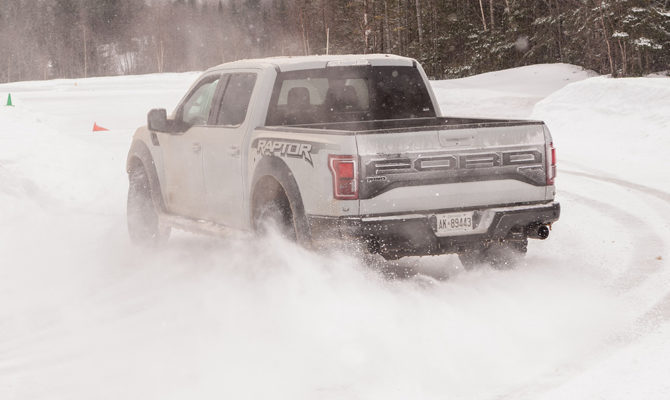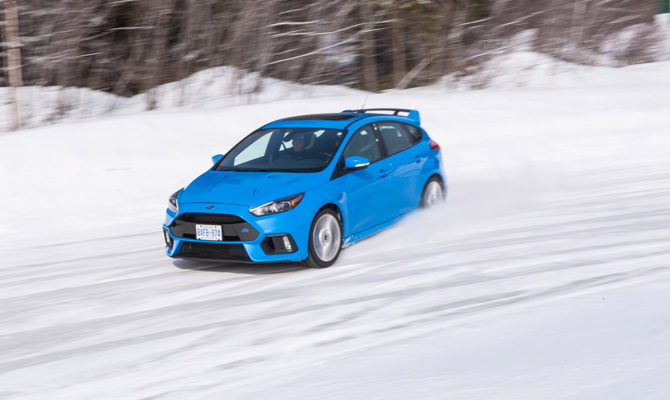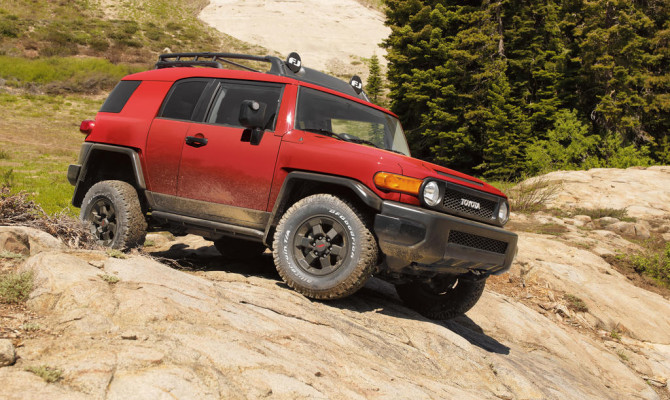(Montreal, QC) I am always down for a winter driving experience, let me tell you – and I don’t just mean what I get from everyday life out here in the Paris of the Prairies, Edmonton, either.
Ford Canada structured an event at the renowned Mecaglisse driving facility here in southern Quebec to show of the capabilities of two of the company’s everyday star performers; the 2017 Raptor and Focus RS
Both the Raptor and Focus RS are the progeny of Ford Performance and both are monsters in their respective class – not just on pavement (or in the Raptor’s intended hunting ground, desert) but wouldn’t you know it, both can handle themselves in Canadian winter.
We had a good day for it, too, though it wasn’t looking that way when I arrived in Montreal the day before the event. Like the rest of the country, Quebec has been getting highly variable weather, and where you could normally expect snow we got a day of rain that threatened to sour the winter driving fun; but luck (depending on your definition of ‘luck’) was with us, as the temperature dropped and new snow appeared overnight – covering a thick layer of ice.
The truck was my favourite, of course; the race-running, rally-ready pickup has always been a bundle of fun since its introduction; and the 2017 Raptor brings a new powerplant and transmission to its widened F150 platform.
A 3.5 litre EcoBoost V6 has replaced the eight-cylinder engine of previous generations, with an (also-new) 10-speed automatic transmission marshalling the 450 horsepower output.
Under the tutelage of professional instructors, sliding the lightened Raptor (the 2017 model has shed 227 kilos from the previous) around and ice-and-water course carved into the woods at Mecaglisse proved to be a great deal of fun; and a showcase for not only the power and handling of the vehicle, but the terrain-mode capabilities as well.
There are six programmed modes a driver can select from – as you might expect, the one called “weather” was demonstrated primarily in this exercise – and coupled with an ever-more robust suspension (the Raptor’s standard ‘Fox Shox’ have been enlarged and the length of travel elongated) and exclusive-to-Raptor BF Goodrich KO2 tires, it is up to any off-road challenge.
Which is not to say that a 2017 Raptor can’t mind its manners on regular roads. Take it to the pavement and it provides a ride as smooth (and a cabin as quiet) as, say, an F150 King Ranch; with a passenger environment every bit as well-appointed, I might add.
Now, while the Raptor is a lot of fun on snow and ice, it can’t match the sporty small-car agility of the Focus, especially when kitted out as the 2017 Focus RS (which Ford also brought a small fleet of to the track).
Running on studded tires for our demonstration, it held firm to the sheet of ice beneath our wheels. With a manual gearbox and standard-equip all-wheel drivetrain (which features a really clever torque-vectoring system, designed to modulate the spin of each wheel when you push the Focus RS hard (especially into the icy corners on the track), the car knows how to rock its exceptional power.
The RS is a more aerodynamic and purposefully-designed beast than the standard Focus (and it is also significantly more expensive, coming in at over 50K after taxes and destination fees), made for deep-pocketed buyers with a need for speed.
The centre piece is the 2.3L turbo four-cylinder engine under the hood – potentially 350 horses and a matching 350 lb.-ft. of torque on tap – bolstered with a couple of selectable drive modes; much like the Raptor but with different intent.
There is Track and Drift mode, the results of which are fairly self-explanatory, and the 2017 RS also gets a Launch Control function, for high power takeoffs from a standing start.
I won’t pretend that I mastered them all, of course, I’m not exactly a professional performance driver, but the best thing about situations like this event is that there are extremely talented driving instructors on hand to show wannabes like myself how it is truly done. Right about the time we of the press start to think that we’re getting the hang of handling the Focus RS on the ice, we switch seats and the instructors take us for a hot lap around the course to show us how professionals do it. Good fun indeed!
Frankly, a day of instruction and hands-on demonstrations at the Mecaglisse facility in Ford’s finest high performers is (almost) enough to make me wish winter would stick around a bit longer.
“Having good traction tires helps off-roaders get to where they need to go without being stuck…”
Driving down a gravel road to get to your favorite fishing hole or a day out with your family brings lots of enjoyment.
Getting there requires proper tires. Rocks, potholes, and rough terrain all play are part on how your tires perform.
The main function of any tire is to provide traction. Having good traction tires helps off-roaders get to where they need to go without being stuck. When shopping for an off-road/on road tire there are a few things to consider. Cheap tires are not the best option because “you get what you pay for” definitely applies here.
Some things to consider are high mileage tires and tread wear ratings. Some aggressive mud tires tend to wear a lot quicker than an all-terrain tire.
The next thing to consider is tire size. You can contact the manufacturer or check tire charts that give you variety of sizes to fit your vehicle. The height of your sidewall is important and should be chosen based on the conditions where you drive your truck most often.
If you only drive on the street then a low profile truck tire will be fine, but if you go off-roading then you are going to want more tire in between your rim and the ground. That way you will not bottom out on the rims when the tires encounter rough terrain off-road.
The size of the rim is a personal preference. Popular today are the larger sized rims. Just make sure that the rim and truck tire you choose will fit inside the wheel well of the truck, and don’t forget to upgrade your brakes to help stop this increase in weight.
The Wheel Rim width varies from truck to truck. It can be custom made to suit both on and off road driving conditions. The wheel rim width is rounded off to the nearest half inch of the tire. Usually, the best choice is to have the rim width at about 90 percent of the tread width of the tire. Adequate air pressure is important for a good tire life, handling, and traction. Look through your truck’s owner’s manual, on the sticker inside the driver’s door, or look on the tire itself to find the correct air pressure that you need to maintain them.
Seasonal changes can affect the air pressure of the tires. Cold temperatures are responsible for dropping the air pressure of the tires, and warm temperatures are responsible for increasing the air pressure. A 10 percent swing in the temperatures causes a 1lb. change in the air pressure. Sudden changes in temperature are a good time to check the pressure of the tires.
You can reduce the wear and tear of the truck’s tires by rotating them often. Rotating the tires, keeps the tread wear balanced and can really help when slippery and wet conditions occur. A simple rule about rotating your tires is to do it on every other oil change. Doing this consistent basis, will make the tires last longer and allow a comfortable ride for many, many kilometres.
“Essentially an all-weather tire is a winter tire that can be driven right though the summer months…”
 Motoring TV’s Bill Gardiner is probably the best-known and most popular auto mechanic in Canada.
Motoring TV’s Bill Gardiner is probably the best-known and most popular auto mechanic in Canada.
I met up with the likeable and down-to-earth celebrity wrench-puller for the first time at a Kal Tire store in Vancouver, a while ago, to talk about all-weather tires.
**********
If you’re shopping for tires in January it’s probably because you’ve just realized how ineffective the current set on your car has become in winter driving conditions. Now you’re faced with a tire buying dilemma. All-season tires (a misleading name) generally don’t perform well when the thermometer dips below 7-degrees Celsius and winter (snow) tires also perform far better on the white stuff. Then again, the worst of winter will be over in another month or two… or three.
Many car owners are still not aware that there is another option and it’s called the all-weather tire.
Essentially, an all-weather tire is a winter tire that can be driven right though the summer months, so you don’t have the added expense, hassle and storage issues of swapping tires seasonally. You could say, the all-weather tire fulfils the original promise of the all-season tire.
Roughly 50 per cent of Canadian car owners run the same tires all-year-round and don’t do the summer/winter tire switchover, according to Gardiner. Economic and logistical reasons, especially if you live in an urban area, are forcing more and more consumers to drive on the same set of tires in both summer and winter.
“I get that feedback from a lot of motorists,” said Gardiner. “They don’t like manhandling – tires are dirty and you have to put them in the car and then store them. Some families have two or three cars, so that becomes a lot of tires to stack up.
“Many people also buy a second set of steel rims for their winter tires,” added Gardiner. “Now your car doesn’t look too attractive for five months of the year. And with TPMS (tire pressure monitoring systems) if you don’t replicate that sensor on each wheel you lose an important safety feature. The other thing too, most tire shops have a huge spike in business in November and April, so you have to line-up with a gazillion other people.”
The all-weather tire is also a perfect tire for snowbirds, according to Gardiner. “A lot of them like to get home for Christmas. An all-weather tire performs well on hot-dry roads in those southern states and also on ice and snow when they come back to the frozen north.” An all-weather will also come with the Rubber Association’s snow tire symbol (snowflake inside a mountain) designation on the tire’s sidewall, which is a winter driving requirement in Quebec and all-season tire does not have it.
An all-season tire is designed to provide optimal ride and wear characteristics, according to Gardiner. Some all-season tires that will provide over 140,000 km of tread wear, however, tires also have a “best before” life expectancy.
“In my garage, we typically try to match our customers with a tire that will give them four or five years of good service, based on how much they drive,” said Gardiner.
The Nokian passenger tires that Gardiner highly recommends come with 80,000 km or 100,000 km tread wear guarantees. They also come with a clever DSI (driving safety indicator) feature moulded into the tread that’s patented by Nokian. The largest number that’s still visible (see photo) is the tread depth remaining in millimetres. When the snowflake disappears it’s no longer recommended for use as a winter tire.
There’s also a unique noise reduction feature on every Nokian passenger tire. The outboard tread grove has a dimpled “golf ball” finish. On a golf ball, dimples control airflow over its surface so it can travel a longer distance. They also, however, offer a noise reduction side benefit that’s exploited by Nokian.
Nokian is a Finnish tire company that specializes in winter tires and operates the only permanent winter tire testing facility in the world. It was the first tire maker to offer an all-weather tire in Canada and Kal Tire has an exclusive importation agreement with Nokian.
“Despite the pointy knot digging into the sidewall with extreme pressure, the tire never succumbed to the silent killer in the bush…”
by Rob Rothwell, Driveway
The rush of air escaping a tire is not a sound one hopes to hear deep in the outback.
According to a tire industry study, 84 per cent of tire failures incurred off-road are due to sidewall puncture, often rendering tires irreparable.
So, BF Goodrich has done something about this deflating fact. (more…)
If you only drive on the street then a low profile truck tire will be fine, but if you go offroading then you are going to want more tire in between your rim and the ground…
Tires are one of the most important features of the truck when it comes to improving its ride.
It is vital to make the right choice and then maintain them so they last for a long time. Before you choose the best tire for your truck, it is essential to understand the terms of the truck tire world.
Tires for example are specified in this form – 265/75R/16. The first number is the width of the truck tire, the second number is the aspect ratio or height of the sidewall and the third number is the wheel diameter or rim size.
The height of your sidewall is important and should be chosen based on the conditions where you drive your truck most often. If you only drive on the street then a low profile truck tire will be fine, but if you go off-roading then you are going to want more tire in between your rim and the ground. That way you will not bottom out on the rims when the tires encounter rough terrain off-road.
Wider tires have more contact area with the ground, thus giving your truck a better grip, both on and off road. Your truck’s handling becomes easier because of the bigger tire width. On the other hand, the same wider truck tire will make more noise and may decrease the fuel efficiency of the truck.
Wider tires can also slip more when it rains, not that it rains much in Vancouver.
The size of the rim is a personal preference. The larger sized rims are popular today. Just make sure that the rim and truck tire you choose will fit inside the wheel well of the truck, and don’t forget to upgrade your brakes to help stop this increase in weight. The wheel rim width varies from truck to truck. It can be custom made to suit both on and off road driving conditions. The wheel rim width is rounded off to the nearest half inch of the tire.
Usually, the best choice is to have the rim width at about 90 per cent of the tread width of the tire.
The most important safety aspect of maintenance on your truck is to keep its tires intact and in good shape. A blown tire can cause an accident in an instant. The number one cause of the tire wear and tear is incorrect tire pressure. All the tires on the truck should have consistent air pressure to carry the weight equally. Adequate air pressure is important for a good tire life, handling, and traction.
Look through your owner’s manual, on the sticker inside the driver’s door, or look on the tire itself to find the correct air pressure that you need to maintain them.
Seasonal changes can affect the air pressure of the tires. Cold temperatures are responsible for dropping the air pressure of the tires, and warm temperatures are responsible for increasing the air pressure. A 10 percent swing in the temperatures causes a 1lb. change in the air pressure. Sudden changes in temperature are a good time to check the pressure of the tires.
You can reduce the wear and tear of the truck’s tires by rotating them often. Rotating the tires, keeps the tread wear balanced and can really help when slippery and wet conditions occur. A simple rule about rotating your tires is to do it on every other oil change. Doing this consistent basis, will make the tires last longer and allow a comfortable ride for many, many kilometres.
Recent Comments
- { Enjoyed your Forest of Bowland in the BMW X5M, particularly the photo of the BMW in front of the main part of Stonyhurst College where... }
- { Bantam designed the Jeep, not Willy's or Ford. The American military gave the original Bantam prototype to Willys and Ford to copy. There is plenty... }
- { All Escalades come with a 6.2-lilter V8 engine that produces 420 horsepower. A six-speed automatic is the only transmission offered and drives the rear wheels.... }
- { Alexandra is an excellent journalist. }
Popular Posts
- Journey to a ‘Sparkling’ Luxury Okanagan Resort “Four lucky readers will put a Dodge Journey’s weekend-...
- The Need For Speed: Hike Those Highway Limits More than half of those polled believe the province sho...
- Drives-U-Crazy… Erratic drivers. An early morning drive from Kelowna to Vancouver is nor...
- Readers Respond: The Pros and Cons of Increasing B.C. Speed Limits Increasing the speed limits will only increase risk to...
- Honda CR-V Review: The Compact Crossover To Get Things Done The CRV is a very stylish and aerodynamic crossover veh...






















